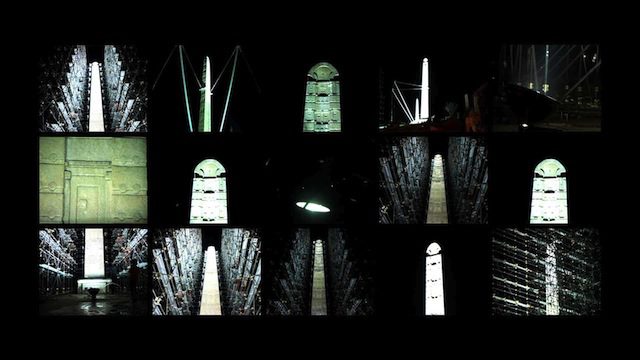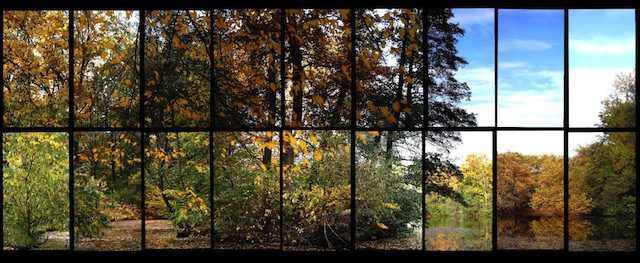C& talks to video artist Theo Eshetu.

Theo Eshetu, The Return of the Axum Obelisk, video installation, 2009 (Courtesy of the artist)
C&: How did you start making videos as your artistic practice?
Theo Eshetu: When I started studying art in 1979, video seemed more interesting than photography. It seemed that there was more to discover in this new medium. I started making videos before VHS was invented. Only some institutions and TV networks had video. Also the fact that you could use the same technology as television to do something, which is just your own view, your own perspective on the world, was a very exciting thing, and certainly television was the most influential visual medium then. It was the medium through which everybody perceived the world. And I thought that the way you saw the world by watching television was not the way that the world really was. For me it was therefore interesting to use the same technology to basically communicate a vision of the world very different from that which is dictated by television.

Theo Eshetu, Veiled Woman on a Beachfront, video installation, 2010 (Courtesy of the artist)
C&: In some major parts of your body of work, the trajectories between Italy and Ethiopia as well as between past and present seem to be a recurrent theme. Why is that?
TE: Actually I make these connections because I’m from Ethiopia and I live in Italy. Then too, the two countries have a history together. To me, it’s more of a personal thing. If I were living somewhere else, my links would be with somewhere else. For me, Italy is the place where I’ve lived, where I grew up professionally. So I’m very influenced by Italian art. I went there from London because I loved Italian filmmakers, and the Renaissance artists, and the beauty. Then, of course, once you start looking at the history, you also start looking behind that façade of beauty. I have made several videos on Ethiopia already. When I started in the ’80s, I was making videos about African–European relationships that were mainly aesthetically based. Because that’s in my DNA: I’m half African, I’m half European. That dialogue between those two worlds is an integral part of me, whether it has historically been positive or negative. So when I was making videos, Africa and Europe were both metaphorical spaces. But at a certain point, I wanted to go to the real Ethiopia in order to make a film about the relationship between actual experience and childhood memory. So in 1997 I made a film about my grandfather, who was a well-known historian. That’s when I started getting interested in my Ethiopian origins and the country’s history. It all started with very personal events.
C&: You have recently shown your installation “The Return of the Axum Obelisk” in Berlin. Can you talk about the work a little bit, how it started… why it challenged you to work on that topic?
TE: My father was working at the FAO (Food and Agriculture Organization) office where the Axum-Obelisk was standing. It is an object I’ve known since my childhood. As I started getting interested in Ethiopian history, that’s when rumors of its return began. I wasn’t only interested in it from a political point of view, but also from a personal one. It was a piece of Ethiopia that was in Rome. So this piece of Ethiopia that was going back to Ethiopia was for me almost the way that I felt. I was living in Europe and at the same time I was going back to Africa, and in particular to Ethiopia. In a way, if you look at history through the lens of biography and personal experience, you get a very different picture from official historical records. The complexity of history is that it is not factual. It’s clear to me that, for example, my installation is very political, but the politics are inside the work. They’re not on the surface. The politics are implicit in the object. I mean the two countries and their relationship; the politics are implicit.
C&: It relies heavily on traditional Ethiopian myths, stories, and rituals, loaded with quite a bit of symbolism. In light of that, you also use video and technology. How did you bring all of those sources together?
TE: That’s also a part of the history. I’m interested in rituals and symbols; I’m interested in them from a symbolic point of view. You look at the obelisk as a symbol, and you define the return of it as a symbolic gesture. My interest in history goes back to pre-history. And it all begins with ritual. And nowadays there are still symbolic gestures, for instance, giving someone a present. We don’t think about it as a ritual. But it is a ritualistic gesture. And I think that a lot of the politics are totally impregnated with rituality. If you look at things as a ritualized relationship, I think you can understand the complexity better.
C&: When talking about public art or art in public space in African cities such as Addis Ababa, the focus is still on representative, political works. Would you think that as more and more young artists work in public space there could be a shift? That public space could open up to artwork free from representation?
TE: I think Addis Ababa is going through changes. In the mid-1990s, when I was there, they put up a new statue of Emperor Menelik. At that time they were still doing military sculptures. But more recently, younger artists have been making works in public spaces. The younger generation of artists is bringing in a bit more of conceptualism. It’s very exciting. But again, that’s also something which is happening in Europe. I think when it was 1968 in Europe, it was 1968 in Ethiopia. The world is connected that way.
C&: Just as you have a connection to Addis: How are you active in the art scene in Addis?
TE: I don’t think I really participate in any art scene as such, and if I do it’s only in the place where I live. But I always like going to Ethiopia and doing projects there. I’ve done about five projects in Ethiopia. I am attracted to it like home.

Theo Eshetu, Kiss the Moment, video installation, 2013 (Courtesy of the artist)
C&: How important is music in your work?
TE: Well, I think music is extremely important because when I started making videos, I didn’t have that many references. So I always thought that video was music for the eyes. Therefore the way I think of making videos is the way a composer might want to compose a piece of music. A composer can compose a piece of music that has a complex story, whether it’s about love, or whether it’s about pain, or whether it’s about the way composer feels about something. I think that that’s how I work with video. I work like a composer, more than like an artist.
C&: Is music per se more “publicly accessible,” more popular than the visual arts?
TE: I think what I find very attractive about music is that it gets straight to your soul. You hear music and it touches you immediately. It talks to you directly, and so my dream is to make videos that touch people directly in the way music does. I like to communicate. I like to touch emotions; or touch sentiments, or touch feelings, and music does that.
.
Interview by Aïcha Diallo
More Editorial